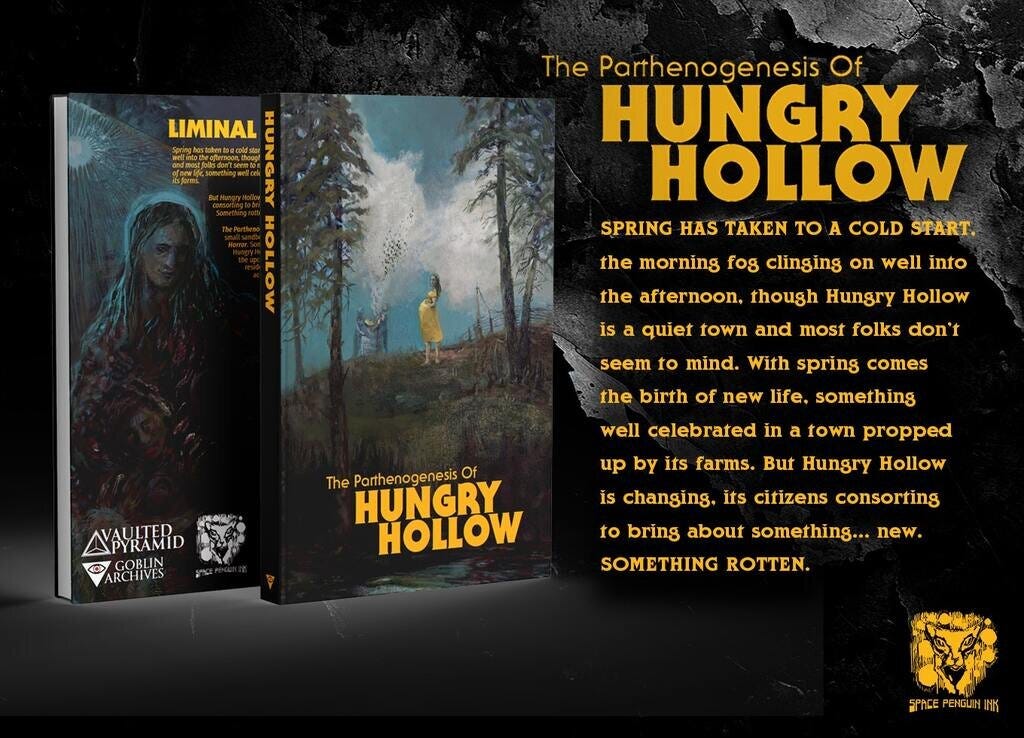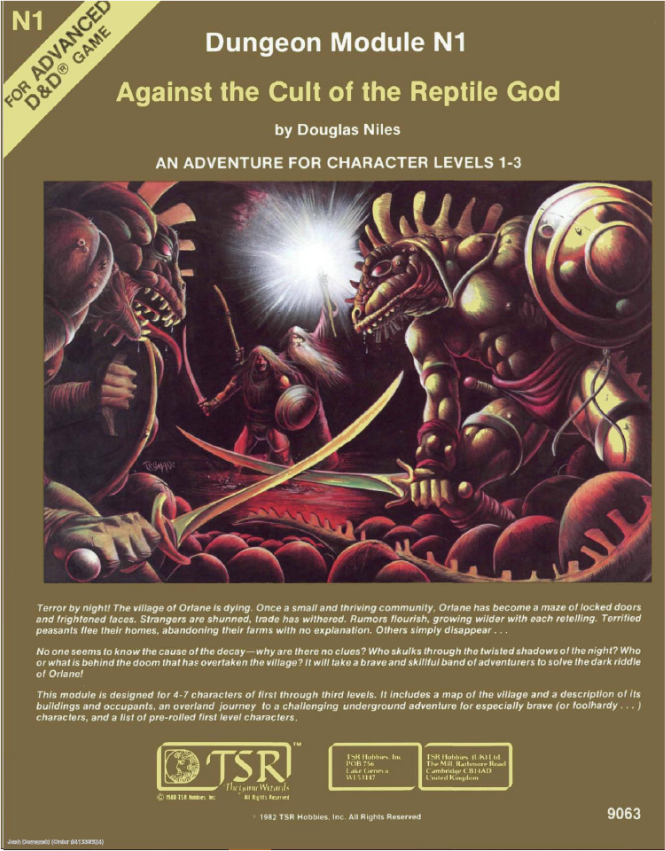Adapting a Mystery Resources
Josh Domanski and I had the pleasure of doing a horror writing seminar on The Weekly Scroll. This was aimed at providing advice on how to adapt a work into an adventure for Liminal Horror. In it’s truest essence, the core tenets presented can be generalized to writing any type of adventure (adaptation or original concepts) into modern horror/Liminal Horror.
This devlog includes the recording (as well as links to the audio and video versions), an adaptation of the slide deck. I’ve included time stamps so you can navigate between the text of the presentation and the recording (since not everyone can devote time to a straight watch/listen/read through). Also because it’ll help you go back to relevant portions.
I have also uploaded docuemtnst that include the slide deck and the Conversion notes (for Into the Odd, B/X, MÖRK BORG, Call of Cthulhu, Delta Green, Monster of the Week, Mothership 1e, Triangle Agency
Links
- Liminal Horror Writing Seminar: Podcast, Youtube, TWITCH
- Seminar Resources (can be found on the Liminal Horror Investigators itch page): itch
- Twisted Classics Jam (open for submissions): https://itch.io/jam/liminal-horror-twisted-classics-jam
- Liminal Horror Library (open for submissions):
- BackerKit for The Parthenogenesis of Hungry Hollow (launches June 5th): https://www.backerkit.com/call_to_action/ea0b6e95-774a-4339-a3b7-30d7feb11a09/landing
- Liminal Horror Discord: https://discord.gg/vqzN5waZgf
Adapting a Mystery
HUNGRY HOLLOW (0:03:35)
The next official entry in the Twisted Classics line, coming to Backerkit on June 1st. Hardcover! New design! 100+ pages! Amanda Lee Franck!
TWISTED CLASSICS
An itch.io jam for making your own Twisted Classic, running from May 14th through August 15th. Join us on the Liminal Horror Discor server for design aid and collaboration.
WHAT IS A TWISTED CLASSIC? (0:05:36)
From the ground up reimaginings of classic adventures and stories that have been twisted to bring them into the era of modern horror.
- Not direct conversions
- Not strictly old adventures
Examples:
What inspired One Night - listening to the Night of Blood episode of Fear of a Black Dragon (Youtube)(Podcast)
What inspired Hungry Hollow - listening to the Against the Cult of the Reptile God episode of Between Two Cairns (Podcast)
What Inspired us to write the
CHOOSING WHAT TO ADAPT (0:07:56)
There are many fantasy and sci-fi adventures and stories that would make great horror scenarios with a simple shift in tone and new coat of paint. They don’t necessarily even need to be focused on horror, as that can always be added later.
Look for:
- A naturally escalating tensions
- A damning secret hidden by facade
- An agent of change, be that to the setting directly or its characters
- A setting that could easily be made to feel right at home in our real life.
DETERMINING WHAT TO SAVE (0:18:06)
How deep of an overhaul does your chosen scenario need to be usable?
- Where possible, simply swap out incongruous locations with their modern analogue.
- Roadside inn → Motel, Blacksmith → Hardware store, etc.
- Find the central tension.
- Break down NPC motivations. Many of them can likely remain as is.
- Money, power, religion, order, etc.
- Determine why the Investigators are there and why they would stay.
- Does changing to modern horror impact this?
- Consider how modern conveniences will effect or change the setting.
ADDING THE HORROR (0:38:55)
For modern settings, horror often comes from a juxtaposition of the mundane against the weird and uncanny. Terrifying creatures, otherworldly entities, ghosts, demons, or even other humans.
- Horrors are an agent of change.
- Might be changing from “alive” to “dead,” but can be more profound.
- Horror should be both environmental and personal. Threaten both the setting and the Investigators. Create clear consequences of inaction.
- Give the horror a goal. What does it want? What happens when it gets what it wants? Horror should rarely be random.
- Use overarching themes with your horrors. This gives you easy elements to return to when you’re running low on ideas.
WRITING CLUES (0:50:55)
Liminal Horror isn’t really a game about solving mysteries, it’s about surviving them. Clues are simply one piece of the toolbox that players will have at their disposal to determine what they do next.
- The act of finding clues should never be hidden behind rolls.
- Progress should never be halted by not finding a particular clue.
- See Doom Clock
- Place your clues in locations that can logically be found through investigation.
- Super obscure clues that can only be found by a specific sequence of events largely won’t be helpful to a GM.
- Some clues may be best as fluid, able to be dropped in where needed.
- See Voidcrawl.
STRESS & FALLOUT (1:00:13)
Stress is a representation of the horrors having a tangible effect on the characters, which will eventually lead to change through Fallout if they are not careful. Stress is the agent that creates change.
- 1 Stress: Witnessing something horrid.
- 1d4 Stress: Particularly horrific scenes or the abilities of minor horrors.
- 1d6 Stress: Abilities of major horrors.
- 1d8+ Stress: Abilities of particularly monstrous entities or witnessing events not meant for human eyes.
Core Text Reference: https://goblinarchives.github.io/LiminalHorror/Investigators/#stress-and-fallout
STAT BLOCKS (1:05:55)
Most basic creatures will simply need HP and STR.
- Ability Scores: 3 is deficient, 6 is weak, 10 is average, 14 is noteworthy, and 18 is legendary.
- HP: 3 HP is average , 6 HP sturdy, 1 0+ HP is serious threat
- HP is Hit Protection, not a measure of Hit Points. It's a measure of skill, luck, drive, resilience.
- Use d6 as the baseline for damage, d4 as the baseline for Stress.
- Including ways to deal stress makes the game more Weird (increases chance of Stress Fallout)
- Critical Damage triggers increase threat or strangeness
Core Text Example Monsters: https://goblinarchives.github.io/LiminalHorror/Investigators/#paranatural-bestiary
STAT BLOCKS - CHEATS (1:15:18)
- Able to avoid being hit? Give it HP.
- Soak up damage? Give it Armor.
- Physically powerful? Give it a high STR or larger damage dice.
- Quick? Give it high DEX.
- Weird? Give it high CTRL or ability to deal Stress Damage.
SANITY (1:20:20)
Liminal Horror has intentionally diverged away from the concept in an attempt to avoid the problematic aspects associated with the stigmatization of mental health struggles. Therefore, replacing Sanity mechanics will not be a simple one-for-one.
- Closest analogue will be Stress and Fallout
- Be wary of simply simulating the “descent into madness” through the use of Fallout.
- Consider what Sanity is meant to elicit in the source material.
Core Text Reference: https://goblinarchives.github.io/LiminalHorror/Investigators/#stress-and-fallout
THE DOOM CLOCK (1:24:08)
An escalating series of events that will come to pass if the Investigators do not act.
- It’s a tool for creating a sense of ramping tension over a period of time.
- Not every scenario is going to benefit from having one.
- Always plan for interference. The players will disrupt the clock, that’s it very design intent.
When to tick forward:
- When it’s most narratively interesting.
- Set interval (Phases, days, real world time.)
- When things start to drag
Examples of different iterations of the Doom Clock in action
- Plague of Frogs (web based)(in print in the Legacy Edition)
- The Mall (digital)(in print)
- The Bloom (digital)(in print)
- The Parthenogenesis of Hungry Hollow (launching soon)
THE DOOM CLOCK SETUP (1:31:53)
Here is one way to structure a slower burn DOOM CLOCK.
- Doom 1 - Calm Before the Storm: Investigators enter the narrative. A sinister plot may already have begun to be spun, but it remains hidden beneath the surface.
- Doom 2 - Omens: Hints that something grander is at play begin to manifest.
- Doom 3 - The Plot Thickens: The situation gets worse. Encounters with the weird increase in frequency, familiar faces disappear, or the environment noticeably changes.
- Doom 4 - The Horror Exposed: The threat is made apparent.
- Doom 5 - Nowhere to Hide: The horror comes knocking, either through direct action against the Investigators and NPCs or indirectly through environmental change.
- Doom - No Turning Back: The Investigators have failed to prevent the horrors from enacting their plans, but all may not be lost.
THE VOIDCRAWL (1:38:08)
A procedure for exploring the dark spaces, using an overloaded encounter die. A replacement for the standard encounter die when you need conflict to aid in driving play forward.
- Day Encounter. Encounters with NPCs or some strange or uncanny occurrence.
- Clue. Hints about the greater mystery at play or warnings that danger is nearby. Something immediately obvious to the Investigators.
- Omen. A portent for things to come. Pick one of the Investigators and roll on the Fallout table of the given scenario, foreshadowing the Fallout they will receive next.
- Setback. Something that impedes progress.
- Horror. Something terrifying or uncanny occurs .
- Night Encounter. Something immediately dangerous or threatening.
Examples of different iterations of the Voidcrawl
CUSTOM FALLOUT (1:50:11)
A representation of the horrors having a tangible effect on the characters. It is both path to power and body horror, wrought through interacting with the horrors directly.
- Fallout often makes you a little weirder, but also a little stronger, some granting strange and frightening abilities.
- Best practice is to directly connect Fallout to the scenario.
- Should reinforce the underlying themes or central tension.
- They are a key sign that you’re not just fighting monster, that the monsters could be you under different circumstances.
Liminal Horror Investigators provides examples of general fallouts and includes the custom fallouts from different modules:
PRACTICAL EXAMPLES (1:59:02)
Adaptations can come from any source of inspiration that has merit in the lens of modern horror, not just old adventures.
- The Picture of Dorian Gray - An artists has gazed upon another world, a shifting world, rendering it in canvas and oil. Now that painting serves as a gateway of sorts, bleeding the shifting world outward into ours.
- Max Payne - The Investigators find themselves trapped in a nightmare of New York City, draw into this nightmare through a personal trauma. To escape the twisting skyscrapers and winding streets, they must battle against the city’s shadowy denizens and dive deeper into the heart.
- Ravenloft - It’s the 1980s and you’re trapped in the neon high rise of the eccentric billionaire/tech giant Steve Zarovich. While you entered by you’re own free will, no door or window has proven to lead back out. Finding Zarovich is the key to your escape.
QUESTIONS
At the end of the seminar Josh and I took questions from the audience.
Items in print
- LIMINAL HORROR INVESTIGATORS Edition https://spacepenguin.ink/collections/liminal-horror/products/liminal-horror-investigators
- One Night at the Shelterwood Inn https://spacepenguin.ink/collections/liminal-horror/products/one-night-at-the-shelterwood-inn
- The Bloom https://spacepenguin.ink/collections/liminal-horror/products/the-bloom
- The Bureau https://www.exaltedfuneral.com/products/the-bureau?_pos=1&_psq=The+bureau&_ss=e&_v=1.0
Items back in stock (after being sold out for quite a while)!
- LIMINAL HORROR LEGACY EDITION (once it’s gone it will be gone forever): https://www.exaltedfuneral.com/products/liminal-horror-pdf
- The Mall https://www.exaltedfuneral.com/products/the-mall
Files
Get Liminal Horror
Liminal Horror
A Modern Horror TTRPG
| Status | Released |
| Category | Physical game |
| Authors | Goblin Archives, Zach Hazard Vaupen // Emo Sludge, Unenthuser |
| Genre | Role Playing |
| Tags | Horror, Monsters, Mystery, OSR, Tabletop role-playing game |
More posts
- Generic Location Preview (keyed maps for your modern horror games)77 days ago
- Deluxe Edition Spreads90 days ago
- Deluxe Edition Layout Has BegunApr 06, 2025
- Last day to enter the physical book giveaway!Mar 01, 2025
- Deluxe Edition Incoming (and a special sneak peak)!Jan 08, 2025
- The Horrors of the Flesh HiveJun 24, 2024
- Sneak Peak: The Parthenogenesis of Hungry Hollow (it's almost fully funded)!Jun 06, 2024
- The Parthenogenesis of Hungry Hollow is live on BackerKitJun 05, 2024
- Hungry Hollow Cover Reveal and BackerKitApr 08, 2024



Leave a comment
Log in with itch.io to leave a comment.